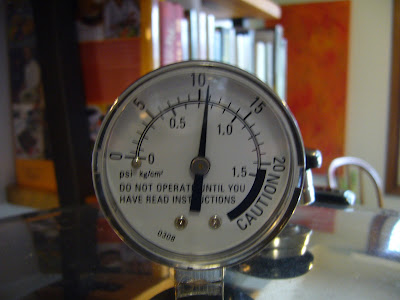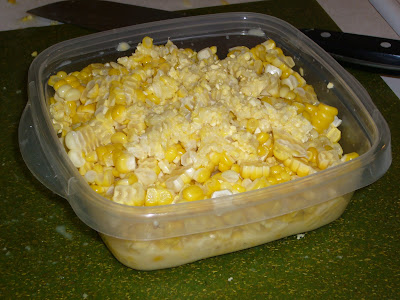Nothing wasted, that's my motto. When processing pumpkin, nothing needs to be wasted. First choose a pie pumpkin, they are usually dark orange and small, the flesh will be sweeter and less watery. Cut the pumpkin in half and scoop our the seeds and stringy bits.
But wait! Don't throw out those seeds, they make a good snack. The stringy bits can be put into the compost, so nothing is wasted there either. Give the pumpkin seeds a quick wash and let them drain while the pumpkin bakes.
Next place the two halfs face down in a cake pan with about a half inch to an inch of water in it, cover with aluminum foil (reused as you can tell from the photo). Place this in a 400 degree oven until the rind side is easily pierced with a fork. When the flesh and rind are soft place on the counter to cool. Once cool scrap the flesh off the rind and if not using in a recipe right away store in 2 cup measurements in a freezer container in the deep freeze and it will keep for months. Most of my recipes call for 2 cups, so that is a convenient amount to have on hand. Now the rind can go into the compost pile as well.

Once the pumpkin is out of the oven the seeds can go in, I usually turn the oven down to 375 degrees so they don't start popping and make a mess in my oven. I spray the pan with non-stick spray, place the seeds in the pan and sprinkle with salt. Bake until they are a light golden brown and crunchy, mmm. I eat the whole seed and spit out any part that seems too woody. Pumpkin seeds are a natural source of most of the B vitamins, along with C, D, E, and K. They also contain the minerals calcium, potassium, niacin, and phosphorous.
Then use the pumpkin flesh for any of the many wonderful pumpkin recipes, such as this wonderful Fruit and Nut Pumpkin Bread. The fruit can be left out if you prefer, I have made it both ways.
Fruit and Nut Pumpkin Bread
2 cups sugar
2 cups pumpkin puree
1 cup vegetable oil
4 eggs
1 teaspoon vanilla extract
3 1/2 cups all-purpose flour
1 1/2 teaspoons ground cinnamon
1 teaspoon salt
1 teaspoon baking soda
1/4 teaspoon ground cloves
1 1/2 cups chopped walnuts
2/3 cup chopped dates
2/3 cup raisins
2/3 cup cranberries
Preheat oven to 350 degrees Fahrenheit.
Grease and flour two bread pans.
In a large bowl, beat the sugar, pumkin, oil, eggs and vanilla until well blended. In another bowl combine the flour, cinnamon, salt, baking soda and cloves. Gradually add to the pumpkin mixture blending well. Fold in the walnuts, dates, raisins and cranberries.
Transfer to prepared loaf pans and bake at 350 for 1 hour and 10 minutes or until a toothpick comes out of the center clean. Makes 2 loaves.


























